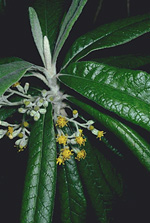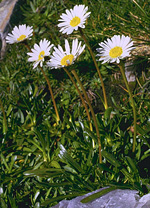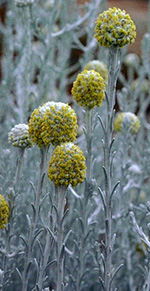 |
One of the largest, most widespread and successful families of flowering
plants, the daisy family has representatives throughout Australia in almost
every vegetation type, although it is most common in fairly open communities,
with few species in rain forests and other closed forests. It is often
a dominant family in the arid zone after rains, and in the high alps.
Many species are naturalized, and occur in disturbed places and on roadsides;
some are serious weeds.
Characteristic features of the family Asteraceae in Australia include: - mostly herbaceous, though some are shrubs and a few form small trees
- flowers almost always in distinctive "daisy-heads" comprising many small flowers together making up a larger flower-like inflorescence, often with differentiated marginal flowers functioning like petals of a normal flower
- flowers 5-partite, with tubular corolla and calyx replaced by scales, spines or hair-like bristles
- anthers united into a tube around the style (but filaments free)
- ovary inferior, comprising a single locule with one ovule, forming a usually dry, seed-like fruit (cypsela) with the persistent calyx (pappus) aiding dispersal on wind or in animals' fur
Description
Evergreen shrubs, woody, or herbaceous vines climbing by tendrils, or annual, biennial or perennial terrestrial herbs; rarely small trees or aquatic herbs rooted in the substrate with their leaves emergent. Tendrils sometimes terminating leaves. If perennial herbs then perennating by tubers or taproots. Vegetative reproduction absent or by tubers or stolons. Stems unarmed or rarely with prickles or spines arising from the stem surface; internodes solid, spongy or pithy or hollow, terete or distinctly angular. Internal secretions not obvious or of milky sap (latex) or coloured sap. Plants glabrous or with simple, glandular or non-glandular, unicellular or uniseriate hairs. Leaves well developed or rarely much reduced, alternate and spiral or opposite, or if herbs cauline, all or mostly basal, or both basal and cauline, petiolate, subsessile or sessile. Stipules and stipellae absent. Lamina simple or once compound, imparipinnate, symmetric or rarely asymmetric, filiform, acicular, subulate, linear, lanceolate, ovate, elliptic, oblanceolate, ovate, oblong or orbicular; base cuneate, attenuate, rounded, cordate or lobed, rarely auriculate, hastate, sagittate or oblique; margins entire, crenate, dentate or serrate or sinuate, ±flat, revolute, recurved, involute or incurved; venation pinnate, with the midrib conspicuous, and the tertiary venation reticulate or not; surfaces not punctate; herbaceous, leathery, succulent or membranous or papery; distinctive odour absent or aromatic or foetid. Domatia absent or consisting of pits or pockets in the vein angles. Male and female flowers occurring on the same plant, or bisexual flowers and either male or female flowers occurring on the same plant, or bisexual and male and female flowers together, or with all the flowers bisexual. Inflorescences terminal or axillary, consisting of 1–many capitula of florets. Bracts present, usually involucral. Bracteoles vestigial or absent. Pollination by insects or rarely by wind. Flowers (florets) odourless, fragrant or malodorous; sessile. Floral nectaries absent or on the carpels. Perianth of 1 whorl only, or apparently of 2 very dissimilar whorls, rarely absent or vestigial. True calyx absent, usually replaced by a regular, papery structure of 0–numerous plumed hairs (pappus), bristles or scales. Corolla fused, of one, two or three types: regular (disk florets), irregular or ligulate (ray florets) and filiform (disk or ray florets), funnel-shaped, salver-shaped or tubular, often 1-lipped; disk florets (0–) 3–5-lobed; ray florets (0–) 1-lobed, entire or 3–5-toothed, valvate in bud; florets white, cream, yellow, orange, red, pink, magenta, purple, violet or blue, without contrasting markings, or streaked, spotted, etc, membranous; the disk and ray florets often of markedly different colour. Fertile stamens 5, not clearly correlated with the outer perianth lobes (pappus, bracts or scales, if present), alternating with the corolla lobes (regular flowers), at least partly fused to perianth segments, free of the ovary and style, fused by their anthers, all ±equal. Staminal filaments free. Anthers dorsifixed, not versatile, opening inwards by longitudinal slits; 2-celled; with apical or basal appendages. Ovary inferior. Carpels 2, fused; ovary with 1 locule. Style terminal, single and unbranched, or single and branched above. Ovule 1, sessile; placentation basal. Fruit a dry or fleshy indehiscent cypsela or a drupe; the perianth on the maturing fruit deciduous, rotting or liquefying or dry and persistent. Disseminule macro-surface featureless or with straight hairs or pappus; micro-surface ±smooth, tuberculate, papillate, echinate, verrucose or costate, white, cream, blue, green, brown, grey or black, glossy or dull. Seeds 1 per fruit. Aril absent. Cotyledons 2. Embryo straight.
(Note: this description has been generated from the coded data compiled for the key. Any errors in the key data will be reflected in the descriptions.)
A treatment of the family Asteraceae has not yet been published in the Flora of Australia. It will appear in Volumes 37 & 38.
Australian genera of Asteraceae (as recognised for the Flora of Australia)
† = some species native, others introduced
* = all species introduced
Abrotanella
Acanthocladium
Acanthospermum
*Achillea
Achnophora
Acmella
Acomis
*Acroptilon
Actinobole
Actites
Adenostemma
*Ageratina
*Ageratum
Allopterigeron
*Ambrosia
Ammobium
*Anacyclus
Anemocarpa
Angianthus
*Anthemis
Apalochlamys
*Arctium
*Arctotheca
*Arctotis
Argentipallium
*Argyranthemum
Argyroglottis
Arrhenechthites
*Artemisia
*Aster
Asteridea
*Asteriscus
Athrixia
*Baccharis
Basedowia
Bedfordia
Bellida
*Bellis
*Berkheya
*Bidens
Blainvillea
Blennospora
Blumea
Brachyglottis
Brachyscome
Bracteantha
*Calendula
Calocephalus
Calomeria
Calotis
*Calyptocarpus
Camptacra
*Carduus
*Carpesium
Carthamus
Cassinia
Celmisia
*Centaurea
Centipeda
Centratherum
Cephalipterum
Cephalosorus
Ceratogyne
*Chamaemelum
*Chondrilla
Chondropyxis
*Chrysanthemoides
*Chrysanthemum
Chrysocephalum
Chrysogonum
Chthonocephalus
*Cichorium
*Cineraria
*Cirsium
*Cnicus
Coleocoma
*Conyza
*Coreopsis
*Cosmos
†Cotula
Craspedia
*Crassocephalum
Cratystylis
*Crepis
*Crupina
Cryptostemma
Cymbonotus
*Cynara
Decazesia
*Delairea
Dichrocephala
Dichromochlamys
Dimorphocoma
Dimorphotheca
Dithyrostegia
*Dittrichia
*Echinops
Eclipta
Elachanthus
Elephantopus
*Emilia
Enydra
Epaltes
Epitriche
*Erechtites
†Erigeron
*Eriocephalus
Eriochlamys
Erodiophyllum
Erymophyllum
*Ethulia
Euchiton
Eupatorium
Eurybiopsis
*Euryops
*Evax
Ewartia
*Facelis
*Felicia
*Filago
Flaveria
*Gaillardia
*Galinsoga
*Gamochaeta
Gamolepis
*Gazania
Gilruthia
Glossocardia
Glossogyne
Glossocardia
†Gnaphalium
Gnephosis
*Gorteria
Gratwickia
*Grindelia
*Guizotia
*Gymnocoronis
Gynura
Haeckeria
Haegiela
*Hedypnois
*Helenium
*Helianthus
Helichrysum
Helipterum
*Helminthotheca
Hemistepta
*Hemizonia
*Heterotheca
*Hieracium
Hyalochlamys
Hyalosperma
*Hypochoeris
Isoetopsis
*Iva
Ixiochlamys
Ixiolaena
Ixodia
Kippistia
*Lactuca
Lagenifera
Lagenophora
*Lapsana
*Lasiospermum
Launaea
Lawrencella
Lemooria
*Leontodon
Leptinella
Leptorhynchos
*Leucanthemum
Leucochrysum
Leucophyta
Leuzea
*Logfia
Lordhowea
*Madia
*Mantisalca
*Matricaria
Melanthera
Microseris
Millotia
Minuria
*Montanoa
Moonia
Myriocephalus
Nablonium
Neotysonia
*Notobasis
Odixia
Olearia
*Onopordum
*Osteospermum
Othonna
Ozothamnus
Pallenis
Parantennaria
*Parthenium
*Pentzia
*Petasites
Phacellothrix
*Picnomon
†Picris
Pithocarpa
Pleurocarpaea
Pleuropappus
Pluchea
Podolepis
*Podospermum
Podotheca
Pogonolepis
Polycalymma
Polypteris
Pseudognaphalium
Pterocaulon
Pterygopappus
Pycnosorus
Quinetia
Quinqueremulus
*Reichardia
Rhodanthe
Roldana
Rutidosis
*Schkuhria
Schoenia
*Scolymus
*Scorzonera
Scyphocoronis
†Senecio
Sigesbeckia
Siloxerus
*Silybum
Solenogyne
*Solidago
*Soliva
†Sonchus
Sphaeranthus
*Spilanthes
Stemmacantha
*Stevia
Streptoglossa
Stuartina
Syncarpha
*Tagetes
*Tanacetum
†Taraxacum
Thespidium
Thiseltonia
Tietkensia
*Tithonia
*Tolpis
Toxanthes
*Tragopogon
Trichanthodium
Trichocline
*Tridax
Tripleurospermum
Triptilodiscus
*Urospermum
*Ursinia
*Vellereophyton
*Verbesina
Vernonia
Vittadinia
Waitzia
†Wedelia
*Xanthium
Youngia
*Zinnia

|
  |

Bedfordia arborescens (flowering branch)
Photo: M.Fagg © M.Fagg

Brachyscome nivalis (flowers)
Photo: C.Totterdell © ANBG

Calocephalus brownii (flowers)
Photo: R.Hotchkiss © ANBG

Calocephalus knappii (flowering plant)
Photo: P.Latz © Parks & Wildlife Commission of NT

|
|
|